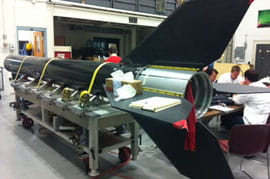Student Rocket Launch a Success

- Drexel's Self-Heating Concrete Is One Step Closer to Clearing Sidewalks Without Shoveling or Salting
- Pinging Pipes Could Help to Identify Lead Water Lines Without Excavation
- MXene-coated Devices Can Guide Microwaves in Space and Lighten Payloads
- Drexel Researchers Propose AI-Guided System for Robotic Inspection of Buildings, Roads and Bridges

A Terrier-Improved Orion suborbital sounding rocket carrying the experiment of four Drexel Mechanical Engineering and Mechanics recently blasted off from NASA’s Wallops Island Flight Facility.
On June 21, students Kelly Collett, Christopher Elko, Danielle Jacobson and their advisor Dr. Jin Kang, of the Drexel Space Systems Laboratory were on hand to watch the rocket carrying their experiment take flight. The launch was expected at 6 a.m., however, it was delayed to allow boats moving through the danger zone to clear the area.
“Before it launched we were all really anxious, but as soon as it went of it was the coolest thing,” Collett said. “It was the most incredible experience of my life,” she added.
The rocket contained 17 educational experiments from universities around the country. Among them was the Drexel team’s piezoelectric cantilevers experiment designed to test the feasibility of using piezoelectric materials to convert vibrations in to storable energy. In other words, the project is designed to capture energy from the vibrations of the rocket during launch.
Currently, batteries on small satellites must be powered down to avoid complications during launch leaving many researchers to wonder if their satellites can be turned on once in orbit. As rockets make their way in to space they release massive amounts of energy through vibration. The students, in coordination with the RockSat-C Cansisterized Satellite Program, plan to test the feasibility of harnessing that energy to power small satellites once in orbit. It’s their hope that one day this method might be used to solve current battery issues.
The rocket launch was visible from Ocean City, Md. The rocket will complete its mission and return to earth where NASA will collect the experiments for delivery to the students for analysis.
In This Article
Drexel News is produced by
University Marketing and Communications.